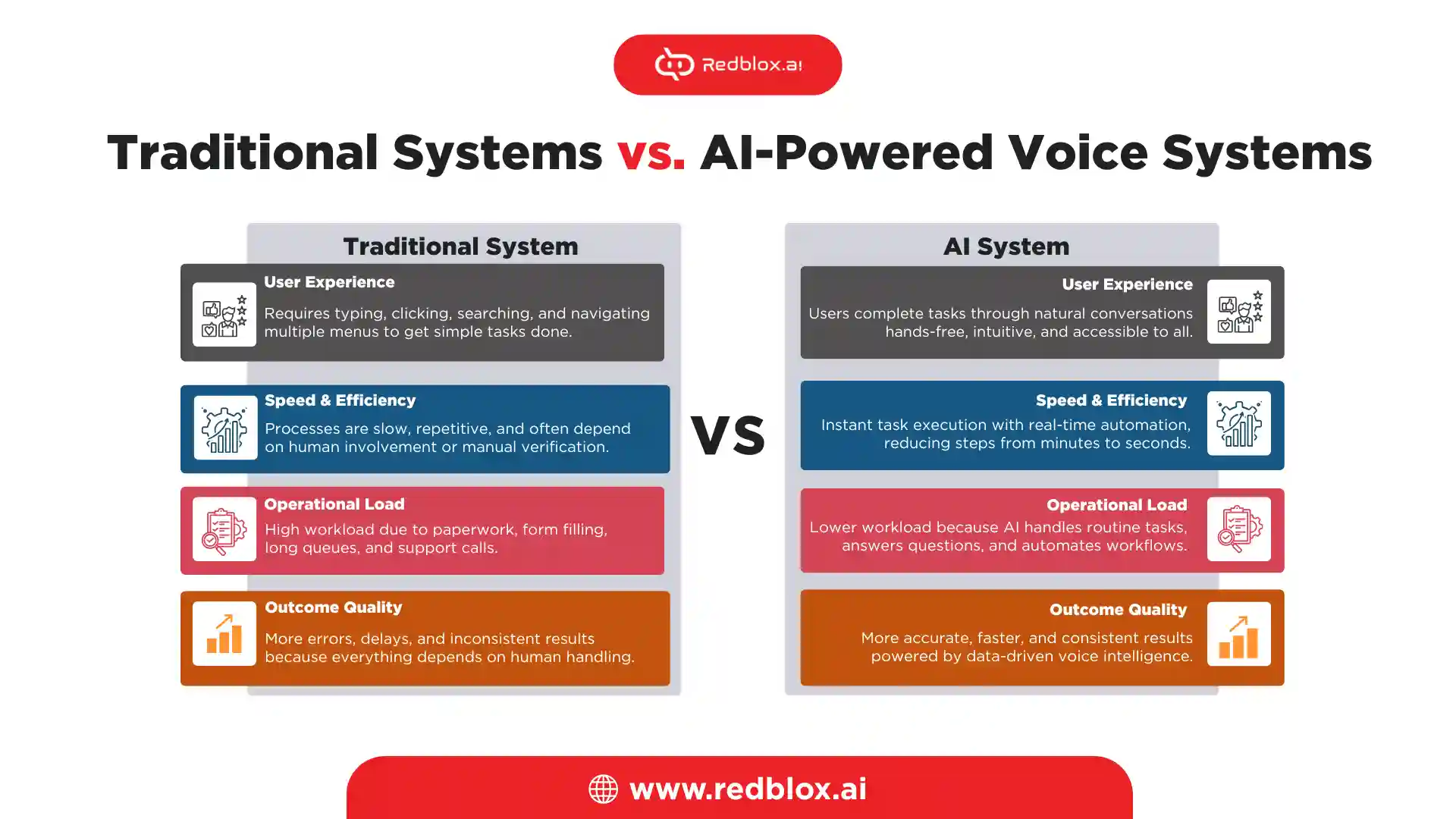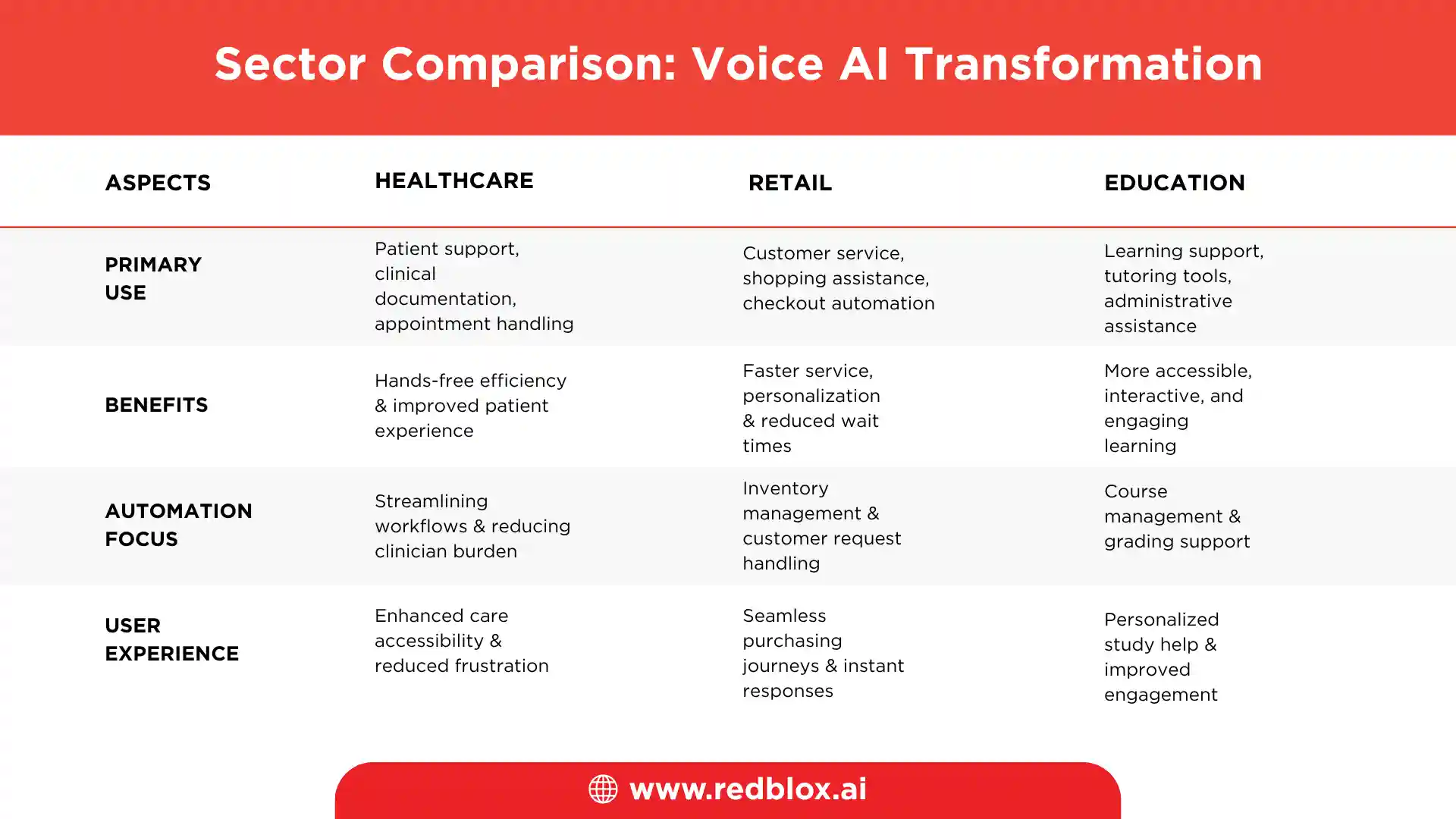Voice AI Transformation Across Industries by 2026
Explore how Voice AI Transformation will reshape healthcare, retail, and education by 2026 with smarter automation and personalized experiences
Published on 18 Nov 2025

How Voice AI Will Transform Healthcare, Retail & Education by 2026
The voice AI transformation will reach over 80% of interactions by 2026 with the AI using voice to conduct its interactions. Previously, voice assistants were basic tools since they performed simple tasks; however, nowadays, they are powerful technologies that are transforming the way we work, learn, and get access to information. This change has rendered daily processes quicker, convenient and more effective.
Healthcare, retail, and education are at the forefront of the movement and voice platforms are making communication, learning, and customer support a necessity.
The reason why voice AI is becoming so significant
Voice AI is increasing as individuals are more likely to speak as opposed to typing. Speaking is effortless, quick and easy. It eliminates friction and enables technology to integrate into the lives of people easily. This has led to the continued development of smarter, more human-like, and able voice assistants each year.
Businesses desire today a technology that is able to:
- Processing large numbers of customers or users.
- Give instant responses
- Give firsthand experiences.
- Reduce operational costs
- Help employees work faster
- Improve accessibility
These are all done simultaneously by voice AI. By 2026 this technology will be more sophisticated, and you will feel like you are conversing with an actual human being, one who is aware of what you like and your previous history and would give you suggestions on what to do.
CTA: Unlock AI Potential
Voice AI in Healthcare, Retail and Education: A single Shift
Although these three industries might appear to be so different, they have common challenges. Healthcare requires improved documentation and patient support. Retail must have fewer customer paths and live services. Studying requires customized education and a sort of on-demand education.
Voice AI is addressing the same issues with the very same capabilities
1. Live communication and comprehension
It can be a healthcare voice assistant, reminding a doctor to note the symptoms, or a voice booth, speaking to a shopper, or voice AI tutors, assisting a student with a math problem—voice AI reduces the time it takes to communicate, which is instant and painless.
2. Personalization
Systems are capable of adapting on the basis of their behavior in the past. This can include knowledge of the medical history of a patient in healthcare. In the retail business, it refers to remembering the style of a customer. AI voice agents in education provide an educational process of modifying learning intensity to an individual.
3. Hands-free interactions
Physicians, warehouse employees, school instructors, parents, students—everyone is happy that they can now communicate with technology without typing or making contact with screens.
4. Availability and accessibility
Voice AI is also used to assist those with disabilities, language barriers, or low literacy. There is no longer a need to read long texts and develop complex forms; you can speak.
5. Automation of data collection
Voice systems convert the people to be talked to to structured data. This aids in making decisions, forecasting and automation—what any industry requires.

Mutual gains in all industries
Although voice AI is applied differently in healthcare, retail, and education, they have numerous advantages in common:
Time savings
Voice AI reduces the number of repetitive tasks and accelerates reaction time.
Better communication
Individuals are able to talk without using lengthy manuals or exploring complicated systems.
Greater accessibility
Voice AI helps individuals who are either poor at typing, reading, or engaging with screens.
Higher accuracy
Voice systems record data in real time, eliminating errors.
Lower costs
Wastage of time and human assistance is minimized through automation.
More satisfied users
Patients are listened to, customers are encouraged and students are mentored.
These advantages are what make voice AI the reason why it is expanding at an equal rate in all industries simultaneously.
CTA: See the Impact today!

Voice AI Makes Everyday Living Easy
Suppose a parent has begun her day. She wakes up and requests her voice assistant to inform her about the school of her child: homework, tests, or deadlines. She has access to AI voice agents in education, where she can listen to summaries, which teachers had to manually type. Even before breakfast, students are able to communicate with AI tutors to receive additional assistance.
In case she is taking care of an elderly parent, a medical voice assistant will remind the parent to take medicine. It reminds them whether their last dose was taken or not, gives a friendly verbal reminder, and can even issue a notification in case anything appears to be wrong. This makes the families feel secure and united.
She later goes to a retail store. She does not have to wander aimlessly, as she can speak to an enabled voice kiosk to find something or to see what is in stock. This is where voice technology in retail will be very convenient. It will transform verbal questions into answers fast, enhancing the shopping experience and decreasing waiting time.
She also uses voice commerce in the retail sector when she needs to reorder the basic items she purchases in the store, and all she does is say, "Reorder the shampoo I bought last month." The system stores her preferences, budget range and delivery schedule.
Voice AI transformation enhances all these interactions, such as school, healthcare, and shopping. They are united with a single thought: technology is supposed to adapt to people, not vice versa.
Voice AI helps professionals to work more efficiently and quicker
Communication and information are needed by doctors and teachers as well as retail employees. But they get confused with their manual work, slow systems or repetitions. voice AI transformations to their working processes, providing them with additional time and attention.
During an appointment, a doctor can be able to talk with a healthcare voice assistant. They do not have to type, to check their symptoms, or to switch between screens; they just talk in a natural way. It is the assistant who records all information, systematises and even reminds the doctor of something he has not added to the record.
Voice AI transformation can be used in the teaching process because a teacher who is lesson-planning may create interactive quizzes or explanations. The teacher could also speak voice commands during a lesson where he or she could take attendance or play learning materials without touching the computer.
A voice-enabled device allows a retail worker to check the inventory without moving around, expertly alter the price, or be informed about the updates that occurred inside the store. This eliminates the use of foot traffic or manual scans. Voice technology in the retail business makes work easier and quicker.
In each of the three areas, staff are more liberated, more precise, and quicker. The outcome is an improved service delivery to patients, shoppers and students.

Voice AI Enhances Customer, Patient and Student Service
Voice-based support systems are one of the most significant changes that are going to occur by 2026. Voice AI provides immediate solutions to the situation instead of having to wait in lines or access websites with complex structures.
This means:
- Healthcare voice assistants provide assistance to patients even at nighttime.
- Voice commerce in retail provides customers with updates on their orders.
- In education, students converse with voice agents on the AI in case they are at a dead end.
- Parents receive voice notifications of school activities.
- Less time waiting, less frustration and more clarity.
CTA: Transform Your Industry
Voice AI brings Personalization Everywhere
Individualization is effective owing to the fact that it makes individuals feel that they are heard. Voice AI is behavioral and makes changes automatically.
For example:
- Voice AI is used in healthcare where a patient mentions pain, and the voice AI processes these words and makes follow-up inquiries.
- Voice AI transformation can be used in retail to store shopping patterns and propose items in accordance with previously used preferences.
- AI tutors can make lessons faster or more challenging depending on the student's performance in education.
Voice personalization will be nearly miraculous by 2026. It will be like speaking to a close acquaintance—not a machine.

Conclusion
Voice AI will be a natural continuation of normal life in 2026. With voice AI transformation, healthcare will provide smarter service, retail will offer a smoother shopping experience, and education will be more personalized as well. Taken altogether, these changes will transform the way we interact, work, shop, and develop. Voice AI transformation is not only a technological development but also the dawn of a world where technology listens, comprehends, and improves human experience.
FAQ
What is voice AI?
Voice AI is a technology that enables computers to comprehend and react to spoken words by taking advantage of machine learning.
What are the advantages of voice AI for businesses?
Businesses can accelerate support and reduce expenses as well as enhance customer experiences. Voice AI also allows the routine work to be automated, allowing teams to concentrate on important work.
What is the cost of establishing a Voice AI?
Prices tend to be between 20,000 and 250,000+ and will depend on the type of voice assistant being simple or one incorporating domain training. Among them are speech recognition, NLP models, integrations, data security, and maintenance.
Is Voice AI correct with medical data?
Yes. Voice AI can achieve high accuracy levels of medical dictation, symptom reporting and clinical workflows when trained on the clinical vocabulary and compliant with medical standards. However, it is subject to the requirements of data quality, environment and model tuning in healthcare applications.
Is it possible to use Voice AI with many languages?
Definitely. Current voice AI solutions can support various languages, accents and dialects and be trained to use area-specific vocabulary. This enables easy accessibility and easier communication between various users across the world.